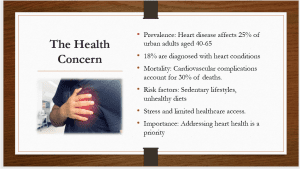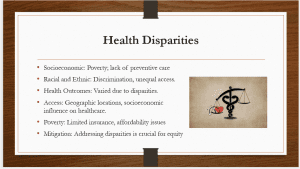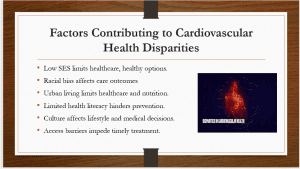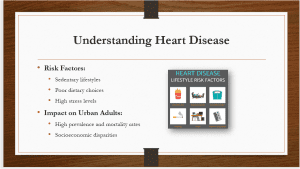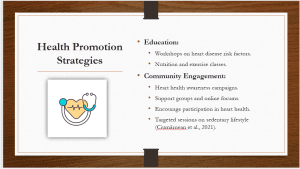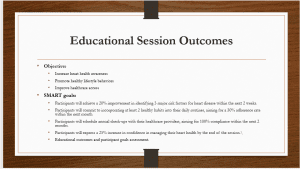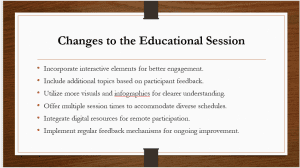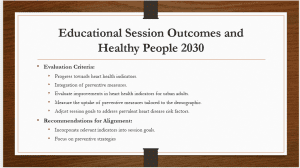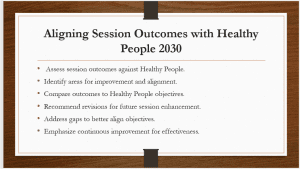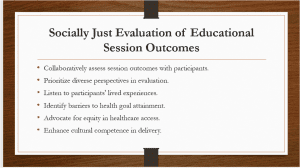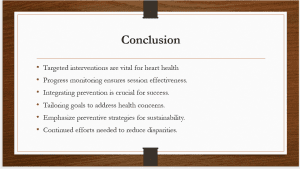Heart Health Strategies – Prevention and Management for a Healthier Future
Hello, everyone. Welcome to today’s session on heart health. We will discuss the strategies for preventing and managing heart disease, aligning our vision with the Healthy People 2030 objectives.
As we delve into heart disease, a critical health concern, we will consider the specific health needs and goals of urban adults aged 40 to 65 years old. These individuals are burdened with specific difficulties, such as living sedentary lives, malnutrition, high stress, and limited health care resources. The purpose of this session will be to enable members of this age group to manage their health and make healthy choices. Notably, urban areas are marked by a high prevalence of cardiovascular diseases, which are one of the leading causes of morbidity and mortality globally. Therefore, local measures become a necessity for reducing the existing health disparities and improving general welfare. In this regard, our objectives are to increase heart health awareness, promote healthy lifestyles, and optimize access to healthcare services.
Among urban adults aged 40-65, heart disease is a most crucial problem, which occurs in about 25% of this population. Concurringly, 18% have already been diagnosed with cardiovascular diseases. Consequently, cardiovascular complications contribute to deaths in approximately 30% of the population. Inactive living, unhealthy eating, high tension, and low healthcare engagement aggravate the problem. It is imperative to consider heart health as a key area of focus so as to reduce the rate of heart disease and improve the health of the community (Nansseu et al., 2019).
Health disparities affect heart health among urban adults aged 40-65. For instance, socioeconomic challenges like poverty limit access to preventive care and healthy lifestyle choices. Racial and ethnic disparities, driven by discrimination and unequal access to healthcare, further exacerbate these inequalities (Obeidat et al., 2023). Consequently, health outcomes vary widely among this demographic due to disparities in access to healthcare services influenced by geographic and socioeconomic factors. Limited insurance coverage and affordability issues stemming from poverty hinder individuals’ ability to seek timely medical care and preventive services. Addressing these disparities is crucial for achieving health equity, underscoring the need for targeted interventions and policies aimed at reducing socioeconomic and racial disparities to promote equitable access to healthcare and improve heart health outcomes.
Recognizing and managing the multitude of factors that affect cardiovascular health disparities is one of the key elements in the process of overcoming them. Socioeconomic status (SES) is one important factor that greatly determines access to healthy food, health care services, and physical activity, with low-class groups facing a higher level of risk. Racial and ethnic disparities make the situation worse since, in medical facilities, minority populations are usually subjected to discrimination, the result of which is incomparable levels of preventive care and treatment by the population. Besides, locations, typically urban areas with minimum healthcare facilities, intensifies these gaps (disparities). Inadequate health literacy, a factor influenced by cultural beliefs, reduces the ability of individuals to understand and deal with variables related to cardiovascular risk and prevention. Lastly, inequities in healthcare access, including insurance coverage and cost-related barriers, hamper timely cardiovascular disease detection and management. Taking all these aspects into account can help obtain equitable heart health outcomes across various populations (Niakouei et al., 2020).
A sedentary lifestyle, poor dietary choices, and high-stress levels are prevalent among urban adults aged 40 to 65, contributing to a high burden of heart disease. Data shows that within this age bracket, heart disease affects 25% of individuals, with 18% diagnosed with heart conditions (Alhabib et al., 2020). Additionally, cardiovascular complications account for 30% of deaths in this group. These risk factors, compounded by socioeconomic disparities and limited access to healthcare, underscore the importance of targeted interventions to address heart health in urban adults aged 40 to 65, promoting healthier lifestyles and reducing the prevalence of heart disease within this demographic.
Course programs intended for 40-65-year-old city residents should emphasize the classes that touch on heart disease risk factors, such as sedentary lifestyles as well as unhealthy eating habits. Driving such nutrition and exercise activities designed specifically for this age group will serve as an assumptive tool that will enable an individual to make better food and life decisions. Although community engagement programs such as heart health campaigns and support groups can instill a feeling of community and inspire people’s inclination towards taking part in heart-healthy activities, these efforts should not end here. These online forums can also be used to disseminate information dealing with heart disease prevention and management in a range of approaches targeting a particular population group. These interventions are necessary to prevent the spread of chronic heart disease among city populations from high death rates and reduce the socioeconomic barriers to health care and health information (Ciumărnean et al., 2021).
A heart health education that targets adults aged 40-65 is characterized by laid-out strategies for promoting cardiovascular health. Participants will be prompted to identify three primary risk factors of heart disease and target a 20% change within 14 days. Moreover, they will participate in adopting two healthy practices into their lifestyle scheduled for the first month with a rate of 30%. Boosting self-efficacy could mean that by the end of the session, the participant will have a 25% increase in confidence in dealing with heart health. Participants are to design a schedule for annual check-ups with healthcare providers, set to have 100% coverage within two months. Next, the initiative requires participation in community groups and online forums for heart health issues, with at least 50% of people attending within a month. This initiative empowers individuals to take charge and take specific actions to improve their heart health and reduce their probability of suffering from heart disease (Lloyd-Jones et al., 2010).
I will assess the success of educational sessions and the triumph of set health objectives through work teaming with the hypothetical participants. This evaluation will include using criteria such as whether participants really set goals and plan on how to achieve them and whether they succeeded. Another dimension that I will look into is the sense of social justice that the session created as the facilitators tried to level the information and resources field and allow equal participation. The co-hearings of outcomes with participants and the consideration of social justice principles in the sessions will be made through me so that my community health interventions will be inclusive, equitable, and responsive too of all individuals especially those who are facing social and economic disparities.
As we transition into our educational session, it is crucial to prioritize participant engagement. We’ll incorporate various strategies to ensure active involvement and meaningful contributions from everyone. This includes utilizing polls and quizzes for instant feedback, facilitating interactive Q&A sessions to encourage questions and insights, organizing breakout sessions for smaller group discussions, integrating role-playing exercises for practical application, establishing online forums for post-session discussions, and potentially offering rewards or certificates for active participation. Together, these strategies aim to create a dynamic and interactive learning environment where everyone feels empowered and motivated to engage with the material.
Changes to the educational session will focus on enhancing participant engagement and satisfaction. Firstly, we plan to introduce interactive workshops to create a more dynamic learning environment. This will involve incorporating activities and discussions to encourage active participation and facilitate a better understanding of the material. Additionally, based on feedback from participants, we will expand the content covered in the sessions to address their specific interests and concerns regarding heart health. We also aim to enhance the visual elements of the presentation by incorporating more visuals and infographics to aid comprehension (Darling-Hammond et al., 2020). Moreover, to accommodate the busy schedules of our participants, we will offer flexible session times, allowing individuals to choose a time that suits them best. Furthermore, we will leverage technology by integrating digital resources, such as online forums or webinars, to enable remote participation for those unable to attend in person. Lastly, we will establish continuous feedback mechanisms to gather insights from participants and make ongoing improvements to the educational sessions.
The evaluation criteria encompass monitoring progress in heart health indicators and integrating preventive measures within the educational session. Assessing improvements in heart health indicators among urban adults involves tracking changes in factors like blood pressure, cholesterol levels, and overall cardiovascular fitness. Concurrently, evaluating the uptake of preventive measures, such as regular exercise, balanced nutrition, and stress management, tailored to the demographic’s needs is essential. To align with these criteria, incorporating relevant indicators into session goals ensures targeted interventions addressing prevalent heart disease risk factors. Additionally, focusing on preventive strategies emphasizes the importance of promoting lifestyle modifications that mitigate cardiovascular risks, thus fostering long-term heart health outcomes within the urban adult population (Gooding et al., 2020).
Absolutely, let’s consolidate the discussion into a cohesive paragraph:
In assessing the educational session’s outcomes, my focus will be on measuring its progress toward the objectives outlined in Healthy People 2030 and its impact on leading health indicators. This involves evaluating how effectively the session addressed specific objectives, such as knowledge dissemination, behavior change, and access to healthcare services, and assessing changes in relevant health indicators within the target population. Through this evaluation, I’ll identify any gaps or areas for improvement, such as content relevance or participant engagement, and highlight the need for revisions to better align future sessions with Healthy People 2030 objectives. By providing clear explanations and actionable recommendations based on the evaluation findings, I aim to enhance the effectiveness and impact of future educational sessions in advancing public health goals.
To evaluate educational session outcomes regarding Healthy People 2030 objectives and leading health indicators, a systematic approach is essential. Firstly, a thorough review of session objectives, typically aimed at increasing awareness and promoting healthy behaviors related to heart health, is conducted. Data from pre- and post-session assessments, surveys, and participant feedback are then analyzed to gauge changes in participants’ knowledge, attitudes, behaviors, and intentions regarding heart health post-session. Next, the session outcomes are compared to specific Healthy People 2030 objectives pertaining to heart disease prevention, physical activity, nutrition, access to preventive healthcare services, and health equity. Identifying discrepancies or gaps between session outcomes and Healthy People 2030 objectives is crucial for improvement. Recommendations for future sessions may include revising content, utilizing interactive teaching methods, and addressing the needs of underserved populations. Emphasizing ongoing evaluation ensures future sessions effectively contribute to achieving Healthy People 2030 objectives and improving population health outcomes.
In community health interventions, integrating social justice principles requires collaborative evaluation of educational session outcomes and health goal attainment with participants. This ensures inclusivity, empowerment, and respect for diverse perspectives. Actively involving participants honors their autonomy and acknowledges social determinants influencing health outcomes.
During the evaluation, prioritizing participants’ voices, acknowledging lived experiences, and addressing barriers are essential. Quantitative outcomes and qualitative impacts are assessed, considering factors like accessibility, cultural sensitivity, and healthcare equity. Through this process, strengths and areas for improvement are identified, including enhancing cultural competence and advocating for policy changes to address systemic inequalities.
Ultimately, evaluating session outcomes in collaboration with participants upholds social justice principles by centering their voices and fostering mutual respect and trust. This leads to more equitable and impactful community health interventions tailored to participants’ needs and challenges.
In conclusion, the evaluation criteria and recommendations for alignment underscore the importance of targeted interventions and preventive strategies in addressing heart health disparities among urban adults. By monitoring progress toward heart health indicators and integrating preventive measures into educational sessions, healthcare professionals can effectively address prevalent risk factors and promote positive lifestyle changes. Incorporating relevant indicators into session goals ensures a tailored approach to addressing specific health concerns, while focusing on preventive strategies to emphasize the long-term benefits of adopting healthy behaviors. Overall, these efforts contribute to reducing the burden of heart disease and improving cardiovascular outcomes within the urban adult population. Continued emphasis on education, community engagement, and access to healthcare services is essential for achieving sustainable improvements in heart health and reducing health disparities.
ORDER A PLAGIARISM-FREE PAPER HERE
We’ll write everything from scratch
Question
Build a slide presentation (PowerPoint preferred) of the hypothetical health promotion plan you developed in the first assessment.
Heart Health Strategies – Prevention and Management for a Healthier Future
Then, implement your health promotion plan by conducting a hypothetical face-to-face educational session addressing the health concerns and health goals of your selected group. How would you set goals for the session, evaluate session outcomes, and suggest possible revisions to improve future sessions?



